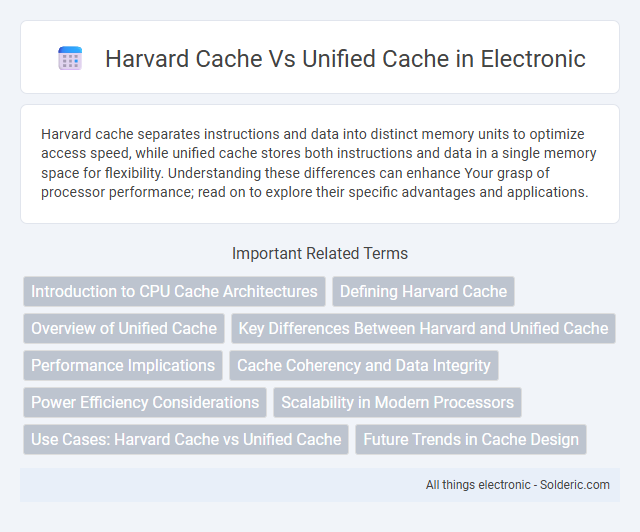Harvard cache separates instructions and data into distinct memory units to optimize access speed, while unified cache stores both instructions and data in a single memory space for flexibility. Understanding these differences can enhance Your grasp of processor performance; read on to explore their specific advantages and applications.
Comparison Table
| Feature | Harvard Cache | Unified Cache |
|---|---|---|
| Architecture | Separate caches for instructions and data | Single cache for both instructions and data |
| Access Speed | Faster due to parallel access | Potentially slower due to shared access |
| Complexity | More complex hardware design | Simpler hardware design |
| Cache Size Efficiency | Less flexible; fixed division between instruction and data caches | More efficient memory utilization |
| Conflict Misses | Reduced, separate caches minimize conflicts | Higher conflict misses possible due to shared cache |
| Typical Use Case | Embedded systems and specialized CPUs | General-purpose processors |
Introduction to CPU Cache Architectures
Harvard cache architecture uses separate caches for instructions and data, enabling simultaneous access and reducing bottlenecks in CPU performance. Unified cache architecture combines instruction and data caches into a single cache, simplifying design but potentially causing conflicts during concurrent access. Choosing between Harvard and unified cache impacts cache hit rates, latency, and overall CPU efficiency in modern processors.
Defining Harvard Cache
Harvard cache architecture separates instruction and data caches, allowing simultaneous access to both memory types, which improves processing speed and efficiency. This contrasts with unified cache, where a single cache stores both instructions and data, potentially causing contention and slower access times. Harvard cache design is particularly advantageous in embedded systems and digital signal processors that require high-throughput and predictable memory access.
Overview of Unified Cache
Unified cache integrates instruction and data caches into a single memory structure, improving cache efficiency by reducing redundancy and increasing hit rates. It simplifies cache management and optimizes access times by allowing dynamic allocation of cache space based on workload demands. Your system benefits from unified cache through enhanced performance in executing mixed instruction and data operations.
Key Differences Between Harvard and Unified Cache
Harvard cache architecture separates instruction and data caches, enabling simultaneous access and reducing bottlenecks, while unified cache combines instructions and data in a single memory space, simplifying cache design but potentially increasing contention. Harvard cache typically offers faster performance for specialized tasks due to parallel processing of instructions and data, whereas unified cache provides flexibility by dynamically allocating cache space between instruction and data as needed. Understanding these key differences helps optimize your system's caching strategy based on workload requirements and performance goals.
Performance Implications
Harvard cache architecture improves performance by allowing simultaneous access to separate instruction and data caches, reducing bottlenecks and increasing throughput. Unified cache consolidates instruction and data storage, which simplifies design and can improve hit rates but may introduce contention between instruction fetch and data access. The choice between Harvard and unified cache impacts processor efficiency, with Harvard cache often benefiting applications requiring high instruction and data parallelism.
Cache Coherency and Data Integrity
Harvard cache architecture separates instruction and data caches, reducing cache coherency issues by isolating reads and writes in distinct memory spaces, but requires explicit mechanisms to maintain data integrity between caches. Unified cache consolidates instructions and data into a single cache, simplifying coherency management through a shared cache controller, but can face contention affecting data consistency. Ensuring cache coherency in both architectures demands robust protocols such as MESI (Modified, Exclusive, Shared, Invalid) to maintain data integrity across cache lines during concurrent access.
Power Efficiency Considerations
Harvard cache architecture, with separate instruction and data caches, allows simultaneous access that reduces pipeline stalls, enhancing power efficiency by minimizing idle cycles and energy wastage. Unified cache consolidates storage for instructions and data, potentially lowering power consumption through reduced cache hardware but may increase access conflicts, causing more frequent cache misses and higher dynamic power usage. Optimizing power efficiency involves balancing the reduced hardware overhead of unified caches with the increased parallelism and throughput efficiency offered by Harvard caches.
Scalability in Modern Processors
Harvard cache architecture enhances scalability in modern processors by separating instruction and data caches, allowing simultaneous access that reduces bottlenecks and increases throughput. Unified cache architecture, while simpler, can face contention issues as the single cache must handle both instructions and data, potentially limiting scalability under high workload demands. Modern processors often implement hybrid approaches or multi-level caches to balance the scalability benefits of Harvard separation with the flexibility of unified cache designs.
Use Cases: Harvard Cache vs Unified Cache
Harvard cache architecture excels in real-time embedded systems and digital signal processing where separate instruction and data caches enhance parallelism and reduce access conflicts. Unified cache is preferred in general-purpose computing and multi-tasking environments due to its flexibility in dynamically allocating cache space between instructions and data. Selecting between Harvard and unified cache depends on workload characteristics, with Harvard caches optimizing latency-sensitive tasks and unified caches benefiting programs with variable instruction-data cache demands.
Future Trends in Cache Design
Future trends in cache design emphasize a hybrid approach that blends the high bandwidth of Harvard cache architecture with the simplicity and flexibility of unified cache systems. Emerging processor designs incorporate adaptive cache hierarchies leveraging machine learning algorithms to dynamically allocate resources between instruction and data caches, optimizing performance and power efficiency. Advances in 3D-stacked memory and non-volatile cache technologies further enable scalable, low-latency caches, addressing the growing demands of AI workloads and heterogeneous computing environments.
Harvard cache vs unified cache Infographic

 solderic.com
solderic.com